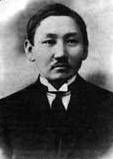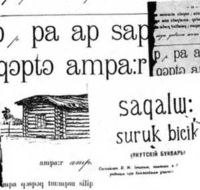
Semyon Novgorodov
Encyclopedia

Yakuts
Yakuts , are a Turkic people associated with the Sakha Republic.The Yakut or Sakha language belongs to the Northern branch of the Turkic family of languages....
politician
Politician
A politician, political leader, or political figure is an individual who is involved in influencing public policy and decision making...
and linguist
Linguistics
Linguistics is the scientific study of human language. Linguistics can be broadly broken into three categories or subfields of study: language form, language meaning, and language in context....
, the creator of a Yakut written language
Written language
A written language is the representation of a language by means of a writing system. Written language is an invention in that it must be taught to children, who will instinctively learn or create spoken or gestural languages....
.
Early life
Semyon Andreyevich Novgorodov was born in the 2nd Khatlinsky nasleg of Boturus Ulus (now Boltoginsky nasleg of Churapchinsky UlusChurapchinsky Ulus
Churapchinsky District is an administrative and municipal district , one of the thirty-four in the Sakha Republic, Russia. It is located in the central part of the republic and borders with Aldansky District in the north, Tattinsky and Tomponsky Districts in the east, Ust-Maysky and Amginsky...
of Sakha). His father was poor, but later acquired some wealth. He taught his son to read Old Church Slavonic
Old Church Slavonic
Old Church Slavonic or Old Church Slavic was the first literary Slavic language, first developed by the 9th century Byzantine Greek missionaries Saints Cyril and Methodius who were credited with standardizing the language and using it for translating the Bible and other Ancient Greek...
. Later, Novgorodov studied under sexton Andrey Vinokurov, who taught him Russian
Russian language
Russian is a Slavic language used primarily in Russia, Belarus, Uzbekistan, Kazakhstan, Tajikistan and Kyrgyzstan. It is an unofficial but widely spoken language in Ukraine, Moldova, Latvia, Turkmenistan and Estonia and, to a lesser extent, the other countries that were once constituent republics...
and arithmetic. Then he visited the private school of exiled I. T. Tsypenko in Churapcha
Churapcha
Churapcha is a village and the administrative center of Churapchinsky Ulus in the Sakha Republic, Russia. Population: 7,526 ; 6,232 ....
. As Semyon was a brilliant pupil, in 1905 he entered Yakutsk
Yakutsk
With a subarctic climate , Yakutsk is the coldest city, though not the coldest inhabited place, on Earth. Average monthly temperatures range from in July to in January. The coldest temperatures ever recorded on the planet outside Antarctica occurred in the basin of the Yana River to the northeast...
Realschule
Realschule
The Realschule is a type of secondary school in Germany, Austria, Switzerland, and Liechtenstein. It has also existed in Croatia , Denmark , Sweden , Hungary and in the Russian Empire .-History:The Realschule was an outgrowth of the rationalism and empiricism of the seventeenth and...
(Реальное училище). During his time at the college, Novgorodov read widely. Novgorodov started to collect Yakut folklore, his works were published in the first Yakut literature magazine Saqa sanata, which was published in 1912–1913.
Yakut writing
As the earliest Yakut writing was invented by Russians, it didn't reflect some features of the Yakut language well. Novgorodov's first writings used a mixture of the Cyrillic and Latin alphabets. After Novgorodov graduated from Realschule, he taught in Yelovsky elementary school and VilyuyVilyuy
The Vilyuy River is river of the Central Siberian Plateau, longest tributary of the Lena River.At a length of approximately 2,650 km long, it is mostly within the Sakha Republic...
municipal school. In 1913 he came to Saint-Petersburg and entered the Arab-Persian-Turkish class of the Oriental department of St.Petersburg University. In December 1913 Novgorodov participated in the All-Russian Congress of Popular Teachers, where he presented a paper about teaching in the national languages of indigenous peoples and the necessity of schoolbooks in the Yakut language.
One year later, Novgorodov entered a Mongol-Manchu-Turkish class. In 1914, on the instructions of Russian Committee on the Exploration of the Central and East Asia, he collected folklore in Tattnsky Ulus, Yakutia. Summer holidays of 1915 he spent in Ufa Governorate
Ufa Governorate
Ufa Governorate was a governorate of Russian Empire with its capital in city Ufa. Was created in 1865 by separation from Orenburg Governorate. March 23, 1919 the governorate was transformed to Bashkir Autonomous Soviet Socialist Republic...
, where he practiced the Tatar language
Tatar language
The Tatar language , or more specifically Kazan Tatar, is a Turkic language spoken by the Tatars of historical Kazan Khanate, including modern Tatarstan and Bashkiria...
of the Tatar colonists and collected folklore of Tiptär Tatars
Volga Tatars
The Volga Tatars are the largest subgroup of the Tatars, native to the Volga region.They account for roughly six out of seven million Tatars worldwide....
.
Exploring a variety of different writing systems, he was attracted by the International Phonetic Alphabet
International Phonetic Alphabet
The International Phonetic Alphabet "The acronym 'IPA' strictly refers [...] to the 'International Phonetic Association'. But it is now such a common practice to use the acronym also to refer to the alphabet itself that resistance seems pedantic...
. He argued for the adoption of this alphabet to the Yakut language. Some Yakut intelligentsia led by poet A. Ye. Kulakovsky opposed him, advocating Cyrillic. Novgorodov's arguments were these:
- Yakut Cyrillic writing had only fifty years of history, and the majority of Yakuts were illiterate.
- There was no convention on the use of the script and it was used in two variants: Betling (the Academic variant) and Khitrov (the Missionary variant).
The main difficulty was caused by numerous umlaut
Umlaut (diacritic)
The diaeresis and the umlaut are diacritics that consist of two dots placed over a letter, most commonly a vowel. When that letter is an i or a j, the diacritic replaces the tittle: ï....
s and brevity and duration signs. Novgorodov found that they reduced the speed of writing. Further, the missionary variant was totally incorrect with respect to pronunciation.
As a public figure

February Revolution
The February Revolution of 1917 was the first of two revolutions in Russia in 1917. Centered around the then capital Petrograd in March . Its immediate result was the abdication of Tsar Nicholas II, the end of the Romanov dynasty, and the end of the Russian Empire...
of 1917. He participated in many meetings and was even elected to the Public Security Committee of Yakutsk. At the First Free Congress of Yakut Peasants, Novgorodov presented his IPA
International Phonetic Alphabet
The International Phonetic Alphabet "The acronym 'IPA' strictly refers [...] to the 'International Phonetic Association'. But it is now such a common practice to use the acronym also to refer to the alphabet itself that resistance seems pedantic...
-based new Yakut alphabet and spoke about the necessity of publishing the first Yakut primer (in collaboration with V.M. Ionov). The congress supported him, and during spring and summer 1917 Novgorodov, with the help of N. Ye. Afanasyev, remade the primer, which was named . However, this alphabet wasn't IPA at all, as some characters were unable to be represented in local presses.
In autumn 1917 he returned to Petrograd to continue his education. In summer 1918 he was contracted as an interpreter to a hydrographic expedition to the Lena River
Lena River
The Lena is the easternmost of the three great Siberian rivers that flow into the Arctic Ocean . It is the 11th longest river in the world and has the 9th largest watershed...
's delta. However, the Russian Civil War
Russian Civil War
The Russian Civil War was a multi-party war that occurred within the former Russian Empire after the Russian provisional government collapsed to the Soviets, under the domination of the Bolshevik party. Soviet forces first assumed power in Petrograd The Russian Civil War (1917–1923) was a...
disturbed his plans. Thus, he ultimately spent 4 months working in Ehirit-Buhachat Aymak of Irkutsk Governorate. As he studied Mongolian, he fluently spoke Buryat language
Buryat language
Buryat is a Mongolic variety spoken by the Buryats that is either classified as a language or as a major dialect group of Mongolian. The majority of Buryat speakers live in Russia along the northern border of Mongolia where it is an official language in the Buryat Republic, Ust-Orda Buryatia and...
and participated in local meetings. In March 1919 he published several articles where he argued for a chair of Yakutology in Irkutsk University and noted to the similarity of modern Yakut and ancient Turkic, found in Orkhon inscriptions
Orkhon inscriptions
"Orkhon inscription" may refer to:*two monuments in the Orkhon valley, see Khöshöö Tsaidam Monuments*inscriptions in the Old Turkic "Orkhon alphabet" in general, see Old Turkic epigraphy...
. Later his theory was verified by other scholars.
In September 1919 Novgorodov reached Yakutsk and joined the Saqa aymaq cultural society. As the Kolchak government didn't support his ideas, he was pleased with the return of Soviet power. He became the head of the Yakutsk Oblast Exploring Department, the head of its linguistic section, a participant of expeditions to the eastern uluses of Yakutia, a lecturer of propagandist and pedagogy courses, a head of the committee for Yakut schoolbooks. As the region had a problem with printing-plants, Novgorodov was entrusted to buy in Central Russia in 1920.
In 1922 he published the re-written primer, . In the same year, the Yakut language was introduced in schools of Yakut ASSR. In 1923, the new Yakut font was made in Petrograd. Another primer, and a book for reading Aaghar Kinige were published. This primer was much better than the others and consisted of five parts: fiction, history, geography, medicine and folklore. In 1923–24 the primer was spread all over Yakutia and likbez
Likbez
Likbez was a campaign of eradication of illiteracy in Soviet Russia and Soviet Union in the 1920s and 1930s. The term was also used for various schools and courses established during the campaign...
y (special schools for illiterates) started their work. As new presses appeared in the republic, it became possible for the local leaders to print their own newspapers and the first of these, , was published in 1923. Until 1930, when Yakut was switched to , more than 200 books were published in the Novgorodov alphabet, including 30 schoolbooks. A new alphabet gave a major impulse to the development of Yakut culture.
In 1922 Novgorodov graduated the university and along with M. K. Ammosov represented Yakutia in Narkomnats
Narkomnats
People's Commissariat of Nationalities was the Government of the Soviet Union body set up to deal with non-Russian nationalities...
(Peoples' Committee for Nationalities). He participated in the commission for delimitation of Yakutia's borders. Also Novgorodov was a deputy of IX Congress of the Soviets, elected by Yakutsk Governorate Congress of the Revolutionary Committee.
Semyon Novgorodov died of uraemia in the prime of his life at February 28, 1924.

